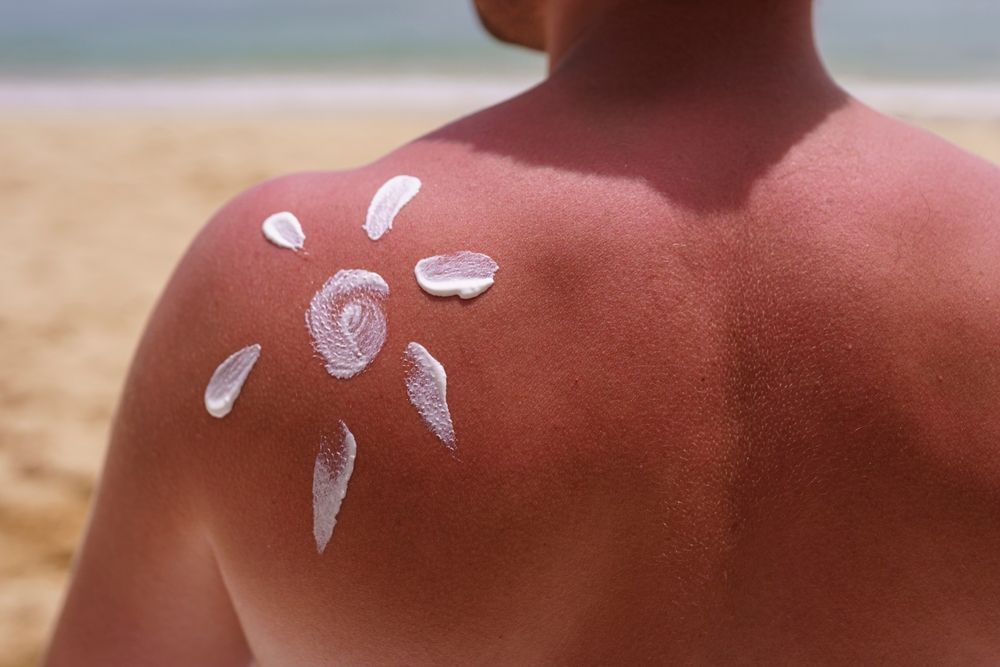Sunburn can turn a delightful day in the sun into an uncomfortable ordeal.
These five effective remedies for pain, peeling, blisters, and swelling will come to your rescue when sunburn strikes.
How do I Know if I’m Sunburnt?
Before we delve into identifying sunburn, it’s imperative to understand what it is. Sunburn is the skin’s reaction to excessive exposure to ultraviolet (UV) light from the sun or artificial sources. This exposure damages the skin cells and blood vessels, prompting the body to increase blood flow to the affected area and triggering an inflammatory response.
Redness:
One of the first signs of sunburn is the reddening of the skin. It can range from a light pink to a deep red, depending on your skin type and the extent of the exposure.
Pain and Tenderness:
The affected area often becomes tender to the touch. You might experience a throbbing pain or a burning sensation, similar to being too close to a heat source.
Swelling:
The inflammatory response might cause swelling in and around the affected area.
Heat:
The sunburnt skin feels warm or hot to the touch due to increased blood flow.
Blisters:
In severe cases, small blisters may form on the skin. These are pockets of fluid that build up as the skin tries to heal itself. It’s important not to pop these blisters as it can lead to infection.
Peeling Skin:
After a few days, the damaged skin may start to peel off. This is part of the body’s natural healing process.
Headache, Fever, and Chills:
In extreme cases, sunburn can cause systemic symptoms like headache, fever, and chills indicating sun poisoning, which is a severe form of sunburn.
Changes in Skin Pigmentation:
Sometimes, even after the skin has healed, there may be changes in skin pigmentation. Dark spots, known as hyperpigmentation, or light spots, termed as hypopigmentation, can develop.
Cooling the Burn
Applying cool compresses or bathing the sunburnt area with cool water can provide immediate relief. This method helps to reduce inflammation and soothe the pain. According to Mayo Clinic, you can apply a clean towel dampened with cool tap water to the affected skin or take a cool bath. This should be done for about 10 minutes several times a day to provide relief. Avoid applying “-caine” products like benzocaine to the affected area, as they can cause skin irritation or even a rare but potentially harmful condition.
Aloe Vera: Nature’s Balm
Aloe vera possesses remarkable properties. It not only reduces inflammation, but also aids in the regeneration of skin cells, thereby promoting the healing process. Moreover, aloe vera gel provides a cooling sensation, which can help alleviate the discomfort associated with sunburn.
By applying a thin layer of pure aloe vera gel multiple times throughout the day, you can effectively soothe and moisturise the affected area. Although aloe vera gel is generally considered safe for topical use, some individuals may experience allergic reactions, particularly if they have allergies to substances like garlic, onions, or tulips. Therefore, it is advisable to exercise caution and discontinue use if any adverse reactions occur.
Stay Hydrated
Sunburn can lead to dehydration as it draws fluid to the skin’s surface. Drinking ample amounts of water helps replenish lost fluids and accelerate skin repair. Mayo Clinic recommends drinking extra water for a day after getting sunburned to help prevent dehydration.
Anti-inflammatory Medication
Over-the-counter anti-inflammatory medications like ibuprofen and acetaminophen can help relieve pain and reduce swelling caused by sunburn. It’s recommended to take a non-prescription pain reliever as soon as possible after getting too much sun.
Or you can try a gel pain reliever that you rub on the skin. It’s essential to use these medications as per the recommended dosages and to consult with a healthcare provider if necessary.
Oatmeal Baths to the Rescue
An oatmeal bath can offer relief to sunburn sufferers due to oatmeal’s natural soothing properties. It involves adding a certain amount of colloidal oatmeal (oatmeal ground into a fine powder) to a bath and soaking the affected area in it.
Please note that all the remedies mentioned above are for mild to moderate sunburns. For severe sunburns, it’s important to seek immediate medical attention.
Your Sunburn Solace: Key Takeaways
Sunburn can be a painful and uncomfortable experience, but there are several effective remedies that can help alleviate the symptoms. Remember to identify the signs of sunburn, such as redness, pain, swelling, heat, blisters, and peeling skin. If you experience symptoms like headache, fever, or chills, it may indicate a severe form of sunburn called sun poisoning, and immediate medical attention is necessary.
References
- Hekmatpou, P. D., Mehrabi, F., Rahzani, P. K., & Aminiyan, P. A. (n.d.). The Effect of Aloe Vera Clinical Trials on Prevention and Healing of Skin Wound: A Systematic Review. PubMed Central (PMC). https://www.ncbi.nlm.nih.gov/pmc/articles/PMC6330525/
- The efficacy of aloe vera used for burn wound healing: a systematic review – PubMed. (2007, September 1). PubMed. https://doi.org/10.1016/j.burns.2006.10.384
- Luo, X., Zhang, H., Wei, X., Shi, M., Fan, P., Xie, W., Zhang, Y., & Xu, N. (2018, February 26). Aloin Suppresses Lipopolysaccharide-Induced Inflammatory Response and Apoptosis by Inhibiting the Activation of NF-κB. PubMed Central (PMC). https://doi.org/10.3390/molecules23030517
- Aloe Vera. (2001, July 11). National Institute of Environmental Health Sciences. https://www.niehs.nih.gov/health/topics/agents/aloe/index.cfm











